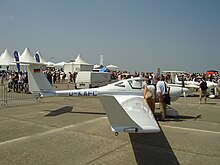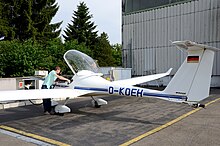Diamond HK36 Super Dimona
| H36 Dimona and HK36 Super Dimona | |
|---|---|

| |
| Diamond HK36 Super Dimona | |
| Role | Motor glider |
| National origin | Austria |
| Manufacturer | Diamond Aircraft Industries |
| Designer | Wolf Hoffmann |
| First flight | 9 October 1980 (H36) October 1989 (HK36R) |
| Status | In production (HK36 Super Dimona) |
| Produced | 1980–present |
| Number built | more than 900 |
| Variants | Diamond DV20 |


The Diamond HK36 Super Dimona is an extensive family of Austrian low-wing, T-tailed, two-seat motor gliders that were designed by Wolf Hoffmann and currently produced by Diamond Aircraft Industries.[1][2][3][4][5][6][7][8]
Design and development[edit]
The series started with the Hoffmann H36 Dimona, a touring motorglider introduced in the early 1980s. The aircraft were initially produced by Hoffmann Flugzeugbau, which became HOAC Flugzeugwerk and later Diamond Aircraft Industries.[2][5][6][9]
Built entirely from fibreglass, the H36 family all use a Wortmann FX 63-137 airfoil. The wings feature top-surface Schempp-Hirth-style airbrakes. Optionally, the wings can be folded by two people in a few minutes to allow storage. The original H36 has 16.0 m (52.5 ft) wings, while the later members of the family added slightly greater span. The H36 offers a 27:1 glide ratio, while later variants improved that by one point, to 28:1 by adding winglets increasing the span to 16.33 m (53.6 ft). Cockpit accommodation seats two in side-by-side configuration, under a hinged bubble canopy that is pushed up and backwards.[1][2][3][4][5][10]
The series are type certified in Europe and North America. The H36 received its US Federal Aviation Administration certification on 9 July 1986. Due to its fibreglass construction, the US certification includes the restriction "All external portions of the glider exposed to sunlight must be painted white except of (sic) wing tips, nose of fuselage and rudder."[6][7]
In March 1987 an improved variant was developed by Dieter Köhler and the subsequent HK36R first flew with a Limbach L2400 engine in October 1989.
When equipped with the larger available engines, particularly the 86 kW (115 hp) Rotax 914 turbocharged powerplant, the aircraft can be used for glider towing. A commercial success, more than 900 H36s and HK36s have been completed.[8]
The HK36 provided the basis from which the Diamond DV20 Katana from which the improved DA20 and four-seat DA40 series were later developed.[9]
Operational history[edit]
In 1991, an HK36, flown by Peter Urach in Austria, set an absolute altitude record in its class for a piston engined aircraft of 36,188 ft (11,030 m). The record held until surpassed in 2002 by the Bohannon B-1.[11]

The FCD (Fuel Cell Demonstrator) was a project led by Boeing that used a Diamond HK36 Super Dimona motor glider as a testbed for a fuel cell-powered light airplane research project. The project achieved level flight using fuel cells only in February and March 2008.[12][13]
In December 2016 there were nine H36s and thirty HK36s registered with the US FAA, two HK36Rs and two HK36TTSs registered with Transport Canada, along with seven H36s and eight HK36s registered with the UK Civil Aviation Authority.[14][15][16]
Variants[edit]
- H36 Dimona
- Original version produced by Hoffmann and later by HOAC, with a 16.0 m (52.5 ft) wingspan, conventional landing gear, 27:1 glide ratio and powered by a Limbach L2000 EB1C engine of 60 kW (80 hp), a Rotax 912A of 60 kW (80 hp) or Limbach L2400 EB of 65 kW (87 hp). Applied for US FAA certificate on 4 April 1982 and received on 9 July 1986 in the utility category at a gross weight of 770 kg (1,698 lb).[2][5][6]


- HK36 R Super Dimona
- Developed from the H36, with a carbon-fibre spar, modified fuselage, 16.2 m (53.1 ft) wingspan and 60 kW (80 hp) Rotax 912A engine. Optional wing tips can extend the span to 17.6 m (57.7 ft). Received US FAA type approval on 23 July 1993 in the utility category at a gross weight of 770 kg (1,698 lb).[2][6]
- HK36TS Super Dimona
- Developed from the HK36 R Super Dimona, the HK36TS has a 60 kW (80 hp) Rotax 912 A3 engine, 16.6 m (54.5 ft) wingspan, 28:1 glide ratio and conventional landing gear. Received US FAA type approval on 25 September 1997 in the utility category at a gross weight of 770 kg (1,698 lb). Marketed as the Katana Xtreme in Canada and the USA.[7]
- HK36TC Super Dimona
- The HK36TC has a 60 kW (80 hp) Rotax 912 A3 engine. Received US FAA type approval on 25 September 1997 in the utility category at a gross weight of 770 kg (1,698 lb). Marketed as the Katana Xtreme in Canada and the USA.[1][3][7][8]

- HK36TC-100 Super Dimona
- The HK36TC-100 has a 74 kW (99 hp) Rotax 912 S3 engine. Applied for US FAA type approval on 16 January 2003 and received on 12 January 2004 in the utility category at a gross weight of 770 kg (1,698 lb).[7] Minimum sink rate: 1.18 m/s at 97 km/h, glide ratio 1:27 at 105 km/h[17] Marketed as the Katana Xtreme in Canada and the USA.[7]
- HK36TTS Super Dimona
- The HK36TTS has an 86 kW (115 hp) Rotax 914 F3 or F4 turbocharged engine, a Muhlbauer MTV-21-A-C-F/CF 175-05 propeller, 16.6 m (54.5 ft) wingspan, 28:1 glide ratio, and conventional landing gear. Received US FAA type approval on 25 September 1997 in the utility category at a gross weight of 770 kg (1,698 lb). Marketed as the Katana Xtreme in Canada and the USA.[1][3][7][8]

- HK36TTC Super Dimona
- The HK36TTC has an 86 kW (115 hp) Rotax 914 F3 or F4 turbocharged engine, 16.6 m (54.5 ft) wingspan, 28:1 glide ratio, and tricycle landing gear. Received US FAA type approval on 25 September 1997 in the utility category at a gross weight of 770 kg (1,698 lb). Marketed as the Katana Xtreme in Canada and the USA.[1][3][7][8]
- HK36TTC Eco Dimona
- Special mission version of the HK36 for the surveillance role, it is equipped with a gimbal-mounted Wescam camera and cockpit display, an 86 kW (115 hp) Rotax 914 F3 or F4 turbocharged engine and a Muhlbauer MTV-21-A-C-F/CF 175-05 propeller. Received US FAA type approval on 29 March 1999 in the utility category at a gross weight of 770 kg (1,698 lb) and 21 December 2000 in the restricted category, limited to aerial photography only, at a gross weight of 930 kg (2,050 lb). Marketed as the Multi Purpose Xtreme in Canada.[7][8]
- Diamond DA36 E-Star
- Developed by Siemens, EADS and Diamond Aircraft to reduce fuel consumption and emissions by up to 25 percent, using a serial hybrid drive that turns the aircraft's prop with a Siemens 70 kW (94 hp) electric motor, from power generated by a 40 hp (30 kW) Austro Engines Wankel rotary engine and generator, stored in batteries. The prototype first flew 8 June 2011.[18]
- Hoffmann H38 Observer
- A surveillance aircraft largely based on the H36 Dimona which failed to enter flight testing due to failure of the partnership between Wolf Hoffmann and Hoffmann Flugzeugbau.[citation needed]
Operators[edit]
Specifications (Hoffmann H36 Dimona)[edit]


Data from Sailplane Directory, Soaring and FAA Type Certificate G51EU[2][5][6]
General characteristics
- Crew: one
- Capacity: one passenger
- Wingspan: 16.0 m (52 ft 6 in)
- Wing area: 15.24 m2 (164.0 sq ft)
- Aspect ratio: 16.8:1
- Airfoil: Wortmann FX 63-137
- Empty weight: 497 kg (1,096 lb)
- Gross weight: 770 kg (1,698 lb)
- Fuel capacity: 80 liters (18 imp gal; 21 U.S. gal)
- Propellers: 2-bladed Hoffmann HO-V 62-R/L 160 T, three position, fully feathering
Performance
- Cruise speed: 182 km/h (113 mph, 98 kn)
- Never exceed speed: 275 km/h (171 mph, 148 kn) sea level to 6000 feet
- Range: 1,090 km (680 mi, 590 nmi)
- Maximum glide ratio: 27:1 at 105 km/h (65 mph)
- Rate of sink: 0.91 m/s (179 ft/min) at 79 km/h (49 mph)
- Wing loading: 48.56 kg/m2 (9.95 lb/sq ft)
See also[edit]
Related development
Aircraft of comparable role, configuration, and era
References[edit]
- ^ a b c d e Activate Media (2006). "Katana Xtreme HK 36TS Diamond". Archived from the original on 29 August 2012. Retrieved 26 July 2011.
- ^ a b c d e f Activate Media (2006). "Dimona H 36 Diamond". Archived from the original on 29 August 2012. Retrieved 26 July 2011.
- ^ a b c d e Activate Media (2006). "Katana Xtreme HK-36 TTS Diamond". Archived from the original on 29 August 2012. Retrieved 26 July 2011.
- ^ a b Activate Media (2006). "Super Dimona HK 36 Diamond". Archived from the original on 29 August 2012. Retrieved 26 July 2011.
- ^ a b c d e Said, Bob: 1983 Sailplane Directory, Soaring Magazine, page 121. Soaring Society of America, November 1983. USPS 499-920
- ^ a b c d e f Federal Aviation Administration (September 2022). "Type Certificate Data Sheet No. G51EU Revision 6". Retrieved 27 July 2023.
- ^ a b c d e f g h i Federal Aviation Administration (January 2004). "Type Certificate Data Sheet No. G07CE" (PDF). Archived (PDF) from the original on 23 December 2016. Retrieved 26 July 2011.
- ^ a b c d e f Diamond Aircraft Industries (n.d.). "HK36 Super Dimona". Archived from the original on 28 July 2011. Retrieved 26 July 2011.
- ^ a b Diamond Aircraft Industries (2010). "Diamond Aircraft - A history". Archived from the original on 9 September 2011. Retrieved 26 July 2011.
- ^ Lednicer, David (2010). "The Incomplete Guide to Airfoil Usage". Archived from the original on 19 July 2011. Retrieved 26 July 2011.
- ^ Flying Magazine, July 2002, pg 36
- ^ "Boeing Announces Partners for Fuel Cell Demonstrator Airplane Project". Archived from the original on 29 June 2011. Retrieved 26 July 2011.
- ^ Niles, Russ (April 2008). "Boeing Flies Fuel Cell Aircraft". Archived from the original on 12 June 2011. Retrieved 26 July 2011.
- ^ Federal Aviation Administration (13 December 2016). "Make / Model Inquiry Results". Archived from the original on 20 December 2016. Retrieved 13 December 2016.
- ^ Transport Canada (13 December 2016). "Canadian Civil Aircraft Register". Retrieved 13 December 2016.
- ^ Civil Aviation Authority (United Kingdom) (13 December 2016). "GINFO Search Results Summary". Archived from the original on 20 December 2016. Retrieved 13 December 2016.
- ^ "Flight manual Diamond aircraft industries, 3.01.12, 9 January 2002". Archived from the original on 8 August 2016. Retrieved 5 August 2016.
- ^ Pew, Glenn (June 2011). "Hybrid Powered Aircraft In Paris". AvWeb. Archived from the original on 27 June 2011. Retrieved 27 June 2011.
- ^ "Airscene: Military Affairs: India". Air International. Vol. 59, no. 3. September 2000. p. 133. ISSN 0306-5634.
